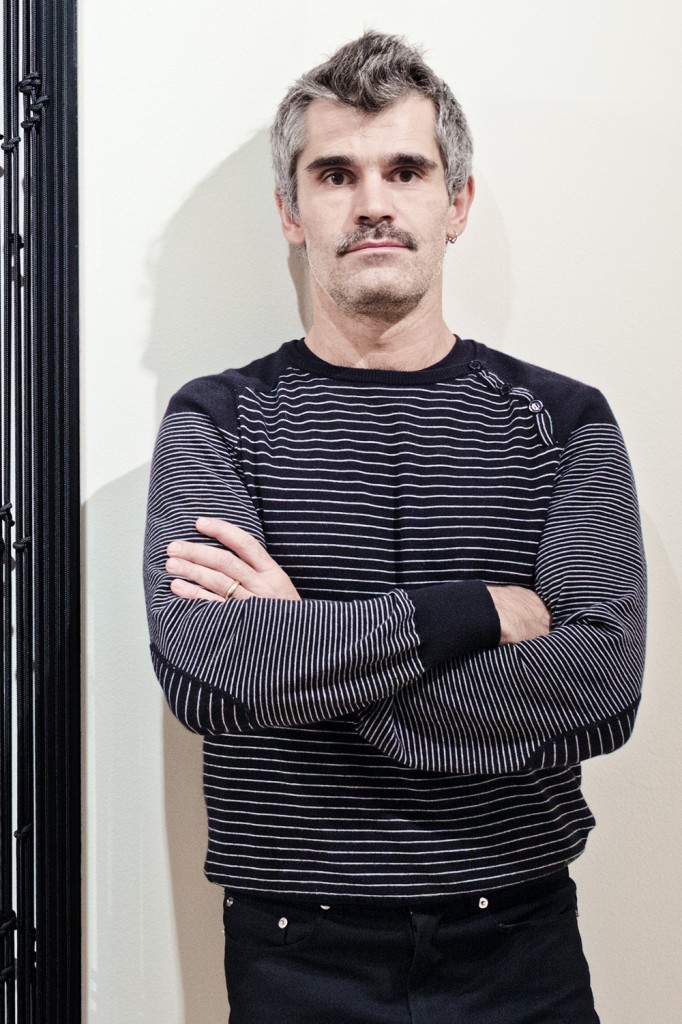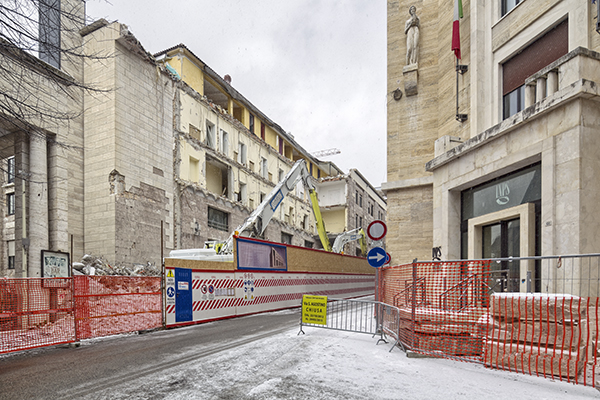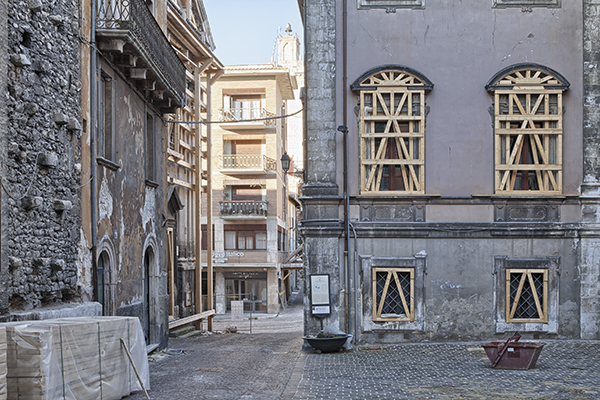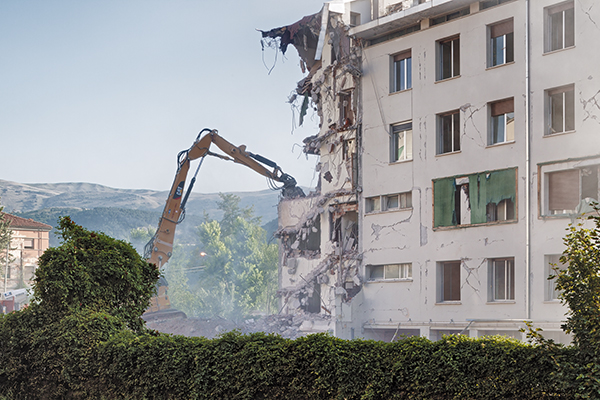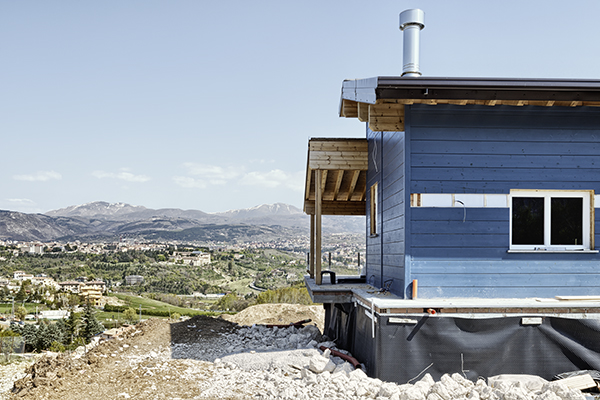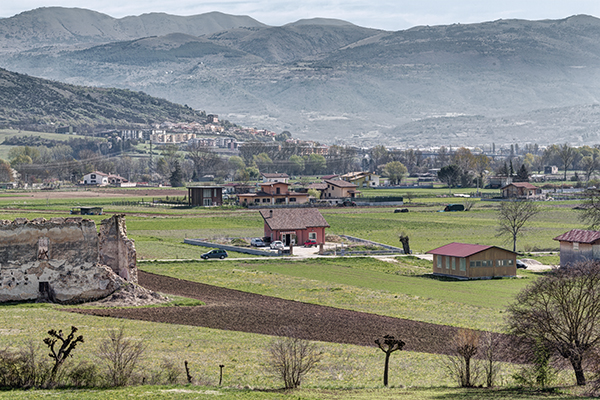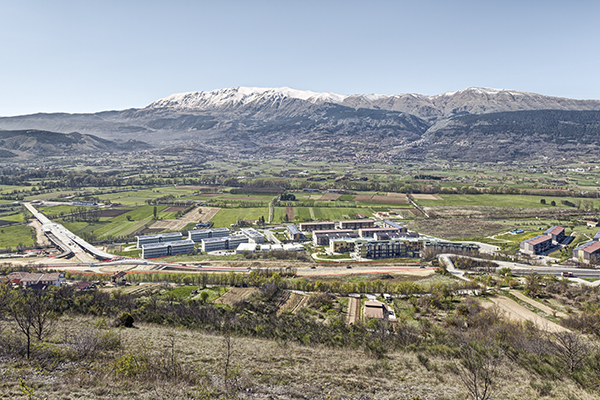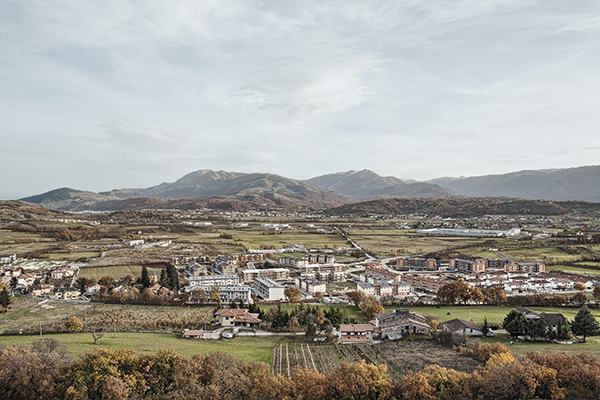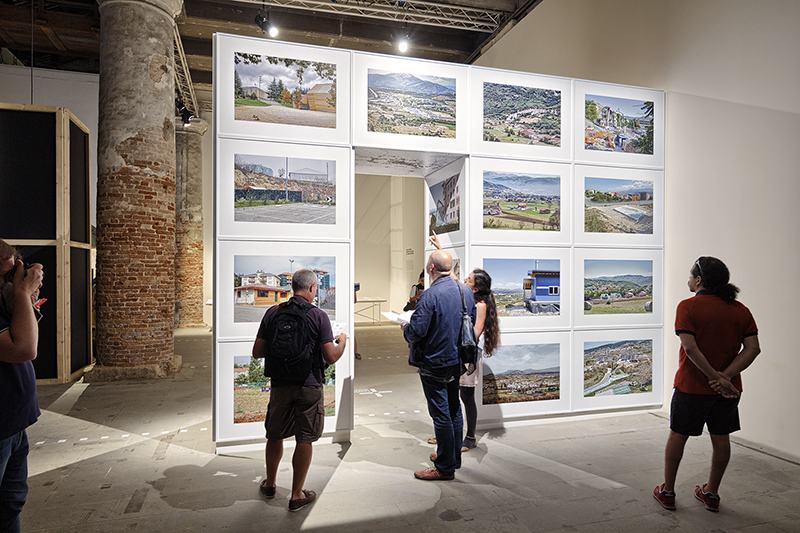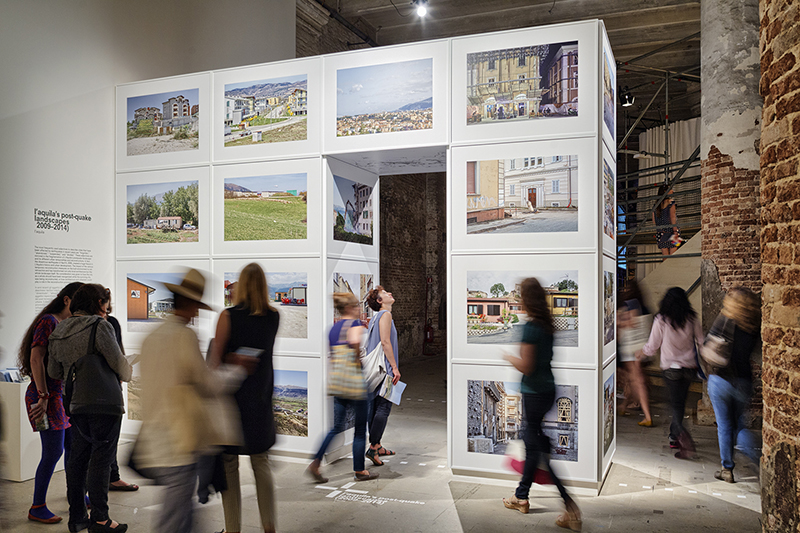Italy, torment and rapture. When one reaches Monditalia, an area of the Venice Biennale of Architecture composed of 82 films and 41 research projects by young architects from all over the world talking about our country, arranged upon a geographical web which envisages, from the south to the north, walking across the entire boot, you’re almost immediately halted in front of a big arch, paneled with 36 large format color photographs which narrate in an unusual and careful way a territory devastated by the earthquake.
L’Aquila’s Post-Quake Landscapes (2009-2014) is a first presentation of a research, which for the past 5 years has observed directly urban, as well as landscape mutations of the city and surroundings of Aquila. The project consists in a visual research exhibited with an archive of micro-stories concerning the social and cultural transformations that had an impact on the physical area of the Aquila enclave, narrated by the campaigners themselves and put together on an internet site which will shortly become a publication www.laquila.professionaldreams.net.
Two architects, Andrea Sarti and Claudia Faraone, have carried out the research project. I meet Andrea Sarti in his Venetian white and tidy office home, filled with extraordinary photographic projects, the most recent concerning the Italian public suburban realms and on the commons of culture. It’s Sunday afternoon, during a summer storm, which turns the canals around San Giacomo all’Orio into a river of dark water.
Your story in a few lines
I was born in La Spezia on the 4th of June 1972, Twins: son of an architect and an arts teacher. From an early age I breathe an air for making ‘stuff’, which I also put straight to work, especially in the building of a house that was a real school for life. My grandfather decided to build in the countryside where he came from and convinced the whole family, especially my brother and I, to help him out. It was the first time I experimented how a building may come into being with one’s own effort, strain and life’s savings. Tiring, nevertheless instructive. I do what I like doing because I wouldn’t be able to do anything different: I’m instinctive.
I attended unwillingly the technical institute for surveyors, I wanted to go to Art College. Sure enough I stopped studying after a while. Then I was called to carry out my military service, where I began to read the art and architecture books I’d take from the shelves of my mother’s library.
It’s here that the idea to study architecture ripened. Towards the end of my draft, I gathered enough licenses to be off duty for a whole month and travelled around Italy in places where you could find university departments of architecture, at the time the entry test wasn’t that advanced and could be done in different cities. Genoa, Florence, Ferrara, Milan, Rome, Venice. It was the city that made me choose the faculty.
When I arrive in Venice the first time, I disembark like everyone at Santa Lucia, I descend the steps of the station very early in the morning. The boat selling fruit is traversing the overlooking canal, the San Simeon Piccolo dome is lit up by the rising sun, right away I figure that this is another world. A city so different to everything else: exactly what I was looking for.
Born in a city by the sea, even the sound of water is sufficient enough. I have it inside of me, it belongs to me, I can’t keep away from it. I chose Venice beyond the shadow of a doubt.
I didn’t know that the University of Venice was so prized as a faculty. These were the last years in which Aldo Rossi would still be teaching, there was also Vittorio Gregotti, Gino Valle, with whom I studied with and who taught me a lot. At the time, also Purini, Secchi, Polesello were teaching: all great theoretical researchers, as well as professionals.
The first two years I lived in Marghera, then in Venice in this house (on two levels where house and office merge in one, all furnished with taste from 30’s modernism to contemporary inserts, such as a Chilean pine wood staircase on a splendid white marble worn-out by time) where at the time we lived up to seven people.
I graduate with Claudia Faraone (his life-long companion, who is originally from Aquila – editor’s note) under the supervision of Bernardo Secchi with Intermittent Cities, a project for the public use of private spaces of the greater city of Venice which was awaiting transformation.
Since then, although we’ve followed different specialization and work routes, Claudia and I collaborated and shared various experiences of urban research, one of which this one here on Aquila.
If you had the choice would you still choose Venice?
If all were as it used to be at the time, yes. Maybe now, with my studies finished and above all with the job I have, I’d probably look more at a metropolitan city, rich in cultural activities and “underground” artistic initiatives. Venice offers many of them, but all to be consumed quickly and in most cases they are not born out of the city’s cultural “milieu”, it’s more for tourists.
Why this passage from architecture to photography? What’s in the middle?
It’s a leap that many do. A huge amount of architecture photographers are architects to start with. I love architecture and I haven’t chosen photography because of a disappointment or a fallback, but because I believe that the photographic view on the built up environment can draw up new spaces and offer different perceptions.
As a student of architecture I was a tireless attender of libraries, first the Querini Stampalia, then the architecture library Tolentini, when around the year 2000 a conspicuous donation of books on photography was made available to the students of IUAV and I went deep into studying them. It’s precisely there with the reviews and books found on the subject that the love of photography matured in me, going over the photographic projects by Ghirri, Chiaramonte, Guidi, Rosselli, Basilico, all great Italian photographers.
I didn’t want to practice photography from the start because I had the intuition it would become too much of a strong passion and would have detached me from the degree in architecture; then thanks to some city planning and design exams, in the beginning of 2000 I had to do some photographs, simultaneously I followed the course by Italo Zannier on the history of photography and from then on it all started. I’m given a Hasselblad my mother used and slowly, slowly I set up a darkroom on the ground floor. The equipment started growing and Porto Marghera was my training gym. Just before my graduation thesis, a friend offered me my first job: photographing interactive lamps for a company from Treviso. I remember I spent everything I’d earned. It was a passion for me and not yet my profession. Right here in this house I make up my first sets, among which a bath filled with water that took up the whole shooting room. I’d ask friends to pose, do a lot of Polaroid, I shot film and lived submerged by meters of transparencies.
I’ve always photographed mainly objects of all sizes and spaces. From 2007, I also started photographing people (up to 2012 he was official photographer for the Peggy Guggenheim Collection of Venice, where besides taking photographs of the set-ups, works and building, would often photograph personalities and celebrities who were visiting – editor’s note). That also was a good training gym. Now my channel is ever more architecture, interiors, museum set-ups and works of art.
A fulfilling moment of your life
You find me at that moment where I must say that this is the one. After years of hard work engaged in growing photographically and having done the same for architecture. Indeed besides the unique opportunity to exhibit at the Biennale, I’m working directly for the exhibitions curated by Rem Koolhaas and OMA-AMO: I did all the photographs for the making of the “Corderie dell’Arsenale” and the central pavilion at the gardens and now I’m shooting the finished work pieces and projects. So I had two roles: dressed as a builder I’d setup my workspace, then, having taken off my overalls, I’d shoot the set-ups and the work exposed!
Why the shape of the arch for your work? What’s the reason behind an architectural symbol in ruins? A bit of an unusual foothold for photographs…
It represents one of many walls that stays impressed when visiting a city hit by earthquake: often collapsed, with no roof, without even a door hanging. It’s an element of construction (the Biennale theme, entitled Fundamentals, editor’s note), a kind of threshold that allows you through to an unknown situation, given the poor media coverage, and not alone, concerning what’s happening to the Aquila area today.
One of our great joys, in fact, is to have brought for the first time within the main Biennale of Architecture the current story of this wound, although it took place five years ago. When the earthquake happened in Chile in 2010, their national pavillon in Venice was devoted to the post-emergency projects, and in 2012 the Japanese pavillon actually won the prize for best pavilion with a post disaster project for Fukushima. We haven’t. We hadn’t done it yet. The national architectural debate chose to ignore Aquila and it’s hard to figure out why. All lasted while the spot lights where pointing on Berlusconi with the project C.A.S.E (Anti-Seismic eco-friendly complexes). Whereas the reconstruction of Aquila will need much time, decades, a lot of patience and attention… and it can’t just be a physical reconstruction, but also a social one. It’s really a typical Italian scene: we reconstruct badly, with no architectural contests and city planning and hardly any social backing. In Aquila to replace the anonymous 1960’s blocks we build some just the same, if possible even worst: an architecture, or better a failure construction industry, built on the same spot more or less as it used to be, a true false. We have a great architectural and city planning tradition, but we forget about it. Or else we want to carry on making mistakes, because maybe it’s easier, it’s simpler to observe these mechanisms from the outside and ignore them, so as not to risk the criticisms brought forward and made against architecture and city planning such as in the cases of Belice, of Irpinia, of Umbria, of Molise. Or else certain mechanisms work better this way without getting committed professionals involved who could bring to light administrative processes concerning directing roles – and I say this because also here in Venice there are scandals related to important building projects (he is referring to the recent arrest of the mayor – which took place on the eve of the opening of the Biennale of Architecture, therefore under the eyes of hundreds of journalists from all over the world, due to corruption allegations tied to the public commission for the building of the Mose, – editor’s note).
Aquila, and Italy as a whole, lost out on an extraordinary chance, although born out of a tragic event that could have been an example of architecture with a capital, a great flagship with which Italy could introduce itself to the whole world. The first instances of the emergency are understandable, priority was given to the buildings related to the emergency: no doubt, a year could easily go by, but then what happened during the other four? With this regard, nothing is done or said.
How have you chosen the order and amount of images to exhibit at the Biennale?
The quantity was dictated by the size of the arch on which they’re exposed. They’re organized by their micro themes: Cities elsewhere, Suspension, Reconstruction, Demolition, Absence, Temporality, Transformations. Descriptive categories, which try to reflect a more complex story from the one that is currently portrayed on Aquila, it’s not quite all put back together and reconstructed and not all destroyed either.
Obviously the photographs are a lot more than 36 and I’m working on publishing a book. Five years filled with photos and another five will go by: from the surrounding area I want to enter and shoot the all-packed-up city where there are a many buildings in reconstruction.
What has Venice given to you?
In Venice I found myself again, I was able to grow and work well. It’s a city in harmony with my character. Here, I haven’t been disrupted, I was able to progress freely. The cultural activities, museums, architecture and historical buildings to visit are plentiful. If you want, you could go around every day of the year.
What have you given to Venice?
I try to show my respect towards Venice, as much as I can. It has a very delicate balance. I’ve respected her also through choosing her, you know, living here is very difficult. You have to be in harmony with her, at times she suffocates you, you don’t understand her, you want to get out and get some air. But when you come back, she is there waiting for you, typical and welcoming and you’re in love with her even more than before.
You are a gourmet, you like to cook. What are your favorite dishes and drinks?
I love quality and authenticity, simple ingredients, because I don’t have an haute cuisine palate, maybe because when little I wasn’t accustomed to tasting particularly complex dishes. There are two things I love and miss a lot and when I return to La Spezia I always eat: panigacci and testaroli, with pesto and ragù. They’re a poor man’s dish, of peasant origin: water and flour. I love beer, it’s incredible how it quenches my thirst after a hard day’s work. The first sip is really fantastic!
Music and books?
Given that most of the music I listen to when I work, I use it in relation to what I’m supposed to be doing, I enjoy electronic or heavy metal, but I also listen to jazz. I read books on photography, related to critiques, to history, to theory. For instance I often re-read the books by Claudio Marra, such as this one, written together with Francesca Alinovi La Fotografa. Illusione o rivelazione? (The woman photographer. Illusion or revelation?) While at the moment I’m reading a book by Roberta Valtorta Luogo e identità nella fotografia italiana contemporanea. (Place and identity in contemporary Italian photography).
A talent you have and one you’re lacking?
Being passionate and dedicating myself wholeheartedly without being frightened away by the difficulties. Maybe I exclude a little what is found on the sidelines, this can be a fault at times, but it allows me not to loose sight of the results I want to achieve.
What have you learnt from Life?
That there aren’t fixed ways to achieve one’s objectives, and that these aren’t tied to a historical period or to a chronology of our life but more to one’s own research itinerary, in which you get lost and find yourself again.
This has taught me not to put myself down. Never.
Translation by Paolo Witte
